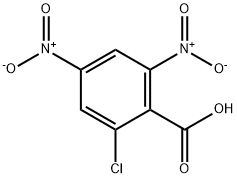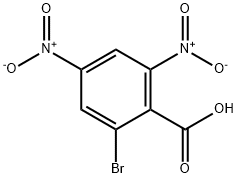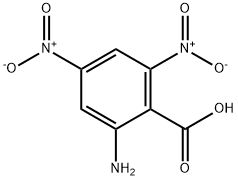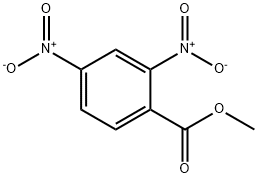2,4-DINITROBENZOIC ACID
- CAS NO.:610-30-0
- Empirical Formula: C7H4N2O6
- Molecular Weight: 212.12
- MDL number: MFCD00017006
- EINECS: 210-219-5
- SAFETY DATA SHEET (SDS)
- Update Date: 2024-12-18 14:07:02

What is 2,4-DINITROBENZOIC ACID?
Chemical properties
pale yellow crystalline powder
The Uses of 2,4-DINITROBENZOIC ACID
2,4-Dinitrobenzoic acid was used in the spectrophotometric determination of diazepam in pure samples and in its pharmaceutical preparations. It was employed as chromophore probe for analysis of perfluorinated carboxylic acids in water by capillary zone electrophoresis. It can be used to produce 2,4-dinitro-benzoyl chloride.
The Uses of 2,4-DINITROBENZOIC ACID
2,4-Dinitrobenzoic acid can be used as a reactant:
- In decarboxylative C-N cross-coupling reactions.
- To synthesize Zwitterionic azaspirocyclic hydantoins by reacting with various carbodiimides via in situ intramolecular dearomatization reaction.
- To prepare 1-(2,4-dinitrophenyl)ethanone by condensation with dimethyl malonate and subsequent decarboxylation reaction.
It can also be used in the spectrophotometric determination of diazepam in pure samples and in its pharmaceutical preparations. In capillary zone electrophoresis, it can be employed as chromophore probe for the analysis of perfluorinated carboxylic acids in water.
Properties of 2,4-DINITROBENZOIC ACID
| Melting point: | 176-180 °C (lit.) |
| Boiling point: | 351.93°C (rough estimate) |
| Density | 1.688 |
| refractive index | 1.5300 (estimate) |
| storage temp. | Store below +30°C. |
| solubility | dioxane: 50 mg/mL, clear |
| pka | 1.43(at 25℃) |
| Water Solubility | 18.2g/L(25 ºC) |
| BRN | 658650 |
| CAS DataBase Reference | 610-30-0(CAS DataBase Reference) |
| EPA Substance Registry System | Benzoic acid, 2,4-dinitro- (610-30-0) |
Safety information for 2,4-DINITROBENZOIC ACID
| Signal word | Warning |
| Pictogram(s) |
 Exclamation Mark Irritant GHS07 |
| GHS Hazard Statements |
H315:Skin corrosion/irritation H319:Serious eye damage/eye irritation |
| Precautionary Statement Codes |
P264:Wash hands thoroughly after handling. P264:Wash skin thouroughly after handling. P280:Wear protective gloves/protective clothing/eye protection/face protection. P302+P352:IF ON SKIN: wash with plenty of soap and water. P305+P351+P338:IF IN EYES: Rinse cautiously with water for several minutes. Remove contact lenses, if present and easy to do. Continuerinsing. P332+P313:IF SKIN irritation occurs: Get medical advice/attention. P337+P313:IF eye irritation persists: Get medical advice/attention. |
Computed Descriptors for 2,4-DINITROBENZOIC ACID
New Products
(S)-3-Aminobutanenitrile hydrochloride 4-Methylphenylacetic acid N-Boc-D-alaninol N-BOC-D/L-ALANINOL Tert-butyl bis(2-chloroethyl)carbamate 3-Morpholino-1-(4-nitrophenyl)-5,6-dihydropyridin- 2(1H)-one Furan-2,5-Dicarboxylic Acid Tropic acid 1-Bromo-3,5-Di-Tert-Butylbenzene S-2-CHLORO PROPIONIC ACID ETHYL ISOCYANOACETATE 2-Bromo-1,3-Bis(Dimethylamino)Trimethinium Hexafluorophosphate 4-IODO BENZOIC ACID 3-NITRO-2-METHYL ANILINE 1-(2,4-DICHLOROPHENYL) ETHANAMINE (2-Hydroxyphenyl)acetonitrile 4-Bromopyrazole 2-(Cyanocyclohexyl)acetic acid 4-methoxy-3,5-dinitropyridine 1-(4-(aminomethyl)benzyl)urea hydrochloride 2-aminopropyl benzoate hydrochloride diethyl 2-(2-((tertbutoxycarbonyl)amino) ethyl)malonate tert-butyl 4- (ureidomethyl)benzylcarbamate Ethyl-2-chloro((4-methoxyphenyl)hydrazono)acetateRelated products of tetrahydrofuran








You may like
-
 2,4-Dinitrobenzoic acid CAS 610-30-0View Details
2,4-Dinitrobenzoic acid CAS 610-30-0View Details
610-30-0 -
 2033-24-1 98%View Details
2033-24-1 98%View Details
2033-24-1 -
 1975-50-4 98%View Details
1975-50-4 98%View Details
1975-50-4 -
 2-HYDROXY BENZYL ALCOHOL 98%View Details
2-HYDROXY BENZYL ALCOHOL 98%View Details
90-01-7 -
 2-Chloro-1,3-Bis(Dimethylamino)Trimethinium Hexafluorophosphate 221615-75-4 98%View Details
2-Chloro-1,3-Bis(Dimethylamino)Trimethinium Hexafluorophosphate 221615-75-4 98%View Details
221615-75-4 -
 61397-56-6 CIS BROMO BENZOATE 98%View Details
61397-56-6 CIS BROMO BENZOATE 98%View Details
61397-56-6 -
 14714-50-2 (2-Hydroxyphenyl)acetonitrile 98+View Details
14714-50-2 (2-Hydroxyphenyl)acetonitrile 98+View Details
14714-50-2 -
 118753-70-1 98+View Details
118753-70-1 98+View Details
118753-70-1
Statement: All products displayed on this website are only used for non medical purposes such as industrial applications or scientific research, and cannot be used for clinical diagnosis or treatment of humans or animals. They are not medicinal or edible.